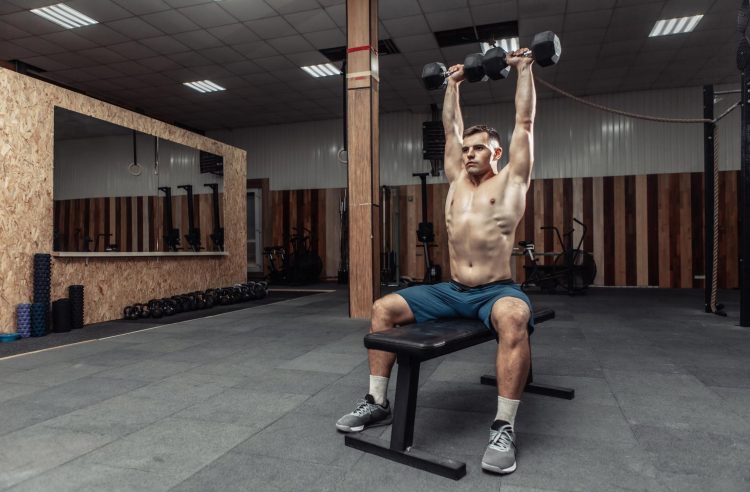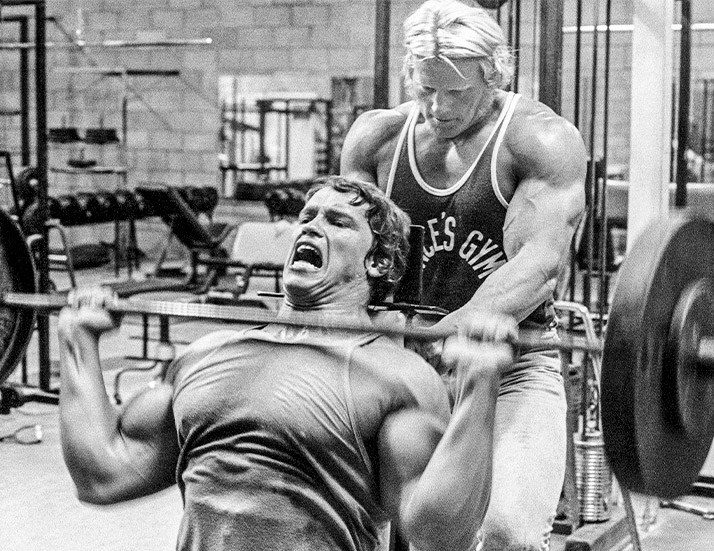Progress plateaus can be very frustrating. Try as you might, your gains grind to a halt and your workouts feel like they’re going nowhere. Almost every lifter will experience training plateaus at some point; they’re part and parcel of working out.
Don’t worry, though – in most cases, sheer persistence will get you over your progress hump. Just keep hitting the gym, and you’ll be fine!
That said, some progress plateaus are self-inflicted and the result of making otherwise avoidable training mistakes. This is arguably the worst kind of plateau because your persistence usually makes matters worse.
As a personal trainer with over 30 years of experience, I’ve spent thousands of hours observing how people train. In addition, I’ve been lifting weights my whole life, training for better sports performance, bodybuilding, and powerlifting. Consequently, I’ve learned what works and what mistakes will undermine your progress.
In this article, I reveal the five most common strength training mistakes and how to fix them.
5 Strength Training Mistakes Everyone Makes
Are you stuck in a progress rut? Frustrating, isn’t it? Avoid these common strength training mistakes, and you’ll soon be back on track.
Level Up Your Fitness: Join our 💪 strong community in Fitness Volt Newsletter. Get daily inspiration, expert-backed workouts, nutrition tips, the latest in strength sports, and the support you need to reach your goals. Subscribe for free!
1. Not Enough Focus on Compound Exercises
Strength training exercises can be classified as isolation or compound movements. While both deserve a place in your workouts, most of your time and energy should go on compound exercises. Not doing enough of this type of exercise will severely undermine your progress. To understand why, let’s take a brief look at isolation vs. compound exercises.
Isolation or single-joint exercises involve relatively few muscles. However, they target those muscles with laser-like precision, making them a good choice for bodybuilders. Examples of popular isolation exercises include leg extensions, leg curls, lateral raises, biceps curls, and triceps pushdowns.
On the downside, isolation exercises limit how much weight you can lift and don’t usually mirror natural movements, so they’re not particularly functional. In other words, they have very little carry-over to activities outside the gym. In addition, you’ll need to use a lot of isolation exercises to train your entire body.
Related: 86 Best Isolation Exercises by Muscle Group
In contrast, compound or multi-joint exercises involve far more muscle groups. This makes them much more time-efficient, and you can train your entire body with just a few well-chosen movements. Compound exercises also mirror the demands and movements of life outside the gym, making them much more functional.
Examples of popular compound exercises include squats, pull-ups, shoulder presses, bench presses, leg presses, lunges, and bent-over rows.
Related: Best Compound Exercises & Lifts for Enhancing Muscle and Strength
In addition, compound exercises allow you to lift heavier loads, exposing your muscles to more muscle and strength-building tension (1). Consequently, doing more compound and fewer isolation exercises will help make your workouts much more productive.
That’s not to say isolation exercises are in anyway bad. They can be useful as workout finishers, bringing up lagging body parts, and for variety. However, building your workouts around compound exercises is arguably the best way to make any strength training program more effective.
Solution: Make sure your workouts contain more compound than isolation exercises. In my experience, an 80/20 ratio works well. That said, using nothing but compound exercises is an excellent option for some lifters.
2. Not Training Hard Enough
Easy workouts do not build muscle and strength. That’s because getting stronger and more muscular are survival responses triggered by stress. Insufficient stress, i.e., an easy workout, means there is no incentive for your muscles to adapt. In short, you need to force your muscles to get stronger and grow.
I often see lifters taking it too easy in the gym. It looks like they’re training hard, but on closer inspection, each set ends way too soon.
So, how do you know if your workouts are hard enough to produce results?
The answer is surprisingly simple – you must take your sets to within a couple of reps of failure (2). However, while such advice is easy on paper, executing it is far harder and means your workouts are about to get much more difficult.
Related: When, Why, And How to Train to Failure
While there are several ways to interpret training to failure, the main takeaway is that you should continue your set until you feel that you only have 1-3 reps left in the tank. This is usually accompanied by plenty of local muscular discomfort (feel the burn!), a noticeable decrease in movement speed, and slight changes in exercise form.
Of course, some exercises are better for training close to failure than others. For example, barbell bench presses and back squats are risky without a power rack or spotter. In contrast, biceps curls and leg extensions are much safer. So, pick the right exercises, and make sure you take any necessary precautions to minimize the risk of injury.
Solution: After your warm-up, take most of your training sets to within 1-3 reps of failure. There is no need to train to complete failure if you don’t want to. However, your workouts will be much more productive if you get close.
3. Ignoring the Importance of Recovery
Intense gains-inducing workouts take a lot out of your body, so you must prioritize recovery if you want to make progress. Ignoring the importance of recovery will hurt your workout performance, undermine your gains, and could even lead to injuries and overtraining.
Level Up Your Fitness: Join our 💪 strong community in Fitness Volt Newsletter. Get daily inspiration, expert-backed workouts, nutrition tips, the latest in strength sports, and the support you need to reach your goals. Subscribe for free!
While it’s true that recovery happens naturally given enough time between workouts, most exercisers want to train more often to make progress faster. This means that recovery needs a helping hand, and you can’t just sit back and let it happen.
Consequently, there are several things you can do that will speed up recovery so you can get back in the gym sooner. This includes:
Get more sleep – consider 7-8 hours a night your minimum sleep target. Sleep is when your body gets busy producing anabolic or muscle-building hormones, repairing and rebuilding muscle cells, and restocking your energy supplies. Too little sleep will severely undermine your progress (3).
Make sure your diet supports your training – your body needs nutrients to recover and grow. While protein is the most obvious macro for strength trainers, your body also needs an abundance of healthy carbs and fats, vitamins, minerals, and fiber. Eat well to give your body the building blocks it needs for recovery and growth.
Include rest days in your training routine – while training every day demonstrates your commitment to the cause, too few rest days will hurt your progress. It’s impossible to say how many days off per week you need, but most people would benefit from 2-3 non-training days. Adjust your workout frequency to match your recovery needs.
Minimize stress – like training, emotional and mental stress take a lot out of your body. Stress causes an increase in cortisol, which is a catabolic hormone that can hurt muscle recovery and growth. Long story short, try to minimize stress to avoid derailing your recovery between workouts.
Solution: Pay as much attention to recovery as you do your workouts. That way, you’ll be able to get back in the gym sooner, and your workouts will be more effective. Ignoring recovery will severely undermine your progress.
Related: 6 Recovery Mistakes Everyone Makes (And How To Avoid Them)
4. Program Hopping
When I was a beginner powerlifter, I was constantly searching for the best powerlifting program. I tried them all – 5/3/1, Starting Strength, Candito, Smolov Jr., and others.
Little did I know that all my program hopping was undermining my progress. So, when I finally picked a program and stuck with it for several months, I actually got stronger and had my best competition results.
I see a lot of program hopping at the gym, and many exercisers have bought into the idea of muscle confusion, believing that they need to change their workouts each week to make progress. Others keep switching workouts in the belief that the right program is the secret to their muscle-building success.
In reality, exercise variety is not a big driver of progress (4). Instead, consistency and progressive overload are what deliver the best gains. There is no “secret program” that guarantees results, so don’t waste your time looking.
Solution: Stop program hopping and find a workout program that a) you enjoy, b) matches your needs and goals, and c) fits seamlessly into your lifestyle. Stick with it for the next 2-3 months, and then find a new routine if or when your progress starts to slow.
5. Ignoring Your Injuries

Lifting weights and minor aches and pains go together like peanut butter and jelly. Intense strength training workouts take a toll on your muscles and joints, often resulting in delayed onset muscle soreness (DOMS) and other sources of mild discomfort.
It’s like the old saying goes, “No pain, no gain!”
However, there is a vast difference between a little post-exercise muscle soreness and injuries you’re ignoring or hoping will go away on their own. Strength trainers are prone to pain in the following joints and body parts:
Training through injuries invariably makes them worse and usually means they take much longer to heal. Working out while hurt can also make your workouts less productive.
For example, shoulder pain will limit how much weight you can bench press, making your workouts less effective for triggering hypertrophy. Additionally, continuing to train will probably make your joint pain worse, delay recovery, and further undermine your progress.
In contrast, taking time off will give your body time to heal so you can come back stronger. Taking time off for injuries doesn’t mean you are lazy or being a wimp. In contrast, it’s the smart thing to do and shows you are playing the long game.
Solution: Don’t be a martyr to your workouts. Instead, avoid training through injuries and let your body heal if you’re hurt. That said, a little discomfort is expected and a standard part of training, but you must know the difference between, e.g., DOMS and a pulled muscle.
Related: Common Bodybuilding Injuries and How to Avoid Them
Closing Thoughts
Strength training does not have to be complicated to be effective. In fact, simple approaches often work best because there is less to go wrong.
So, build your workout program around a few compound lifts, balance it out with a couple of isolation exercises, train consistently and progressively, and respect your body’s need for rest and nutrition.
Rinse and repeat for the next few years, and you’ll reach your strength training goals.
Also, make sure you avoid falling into these strength training traps. While they might seem insignificant, each one of these errors has the potential to undermine your progress, wasting your valuable time and energy in the process.
So, train hard, smart, and consistently – that’s my recipe for long-term strength training success!
Next read: 8 Workout Mistakes Everyone Makes (And How to Avoid Them)
References:
- Schoenfeld BJ. The mechanisms of muscle hypertrophy and their application to resistance training. J Strength Cond Res. 2010 Oct;24(10):2857-72. doi: 10.1519/JSC.0b013e3181e840f3. PMID: 20847704.
- Refalo MC, Helms ER, Trexler ET, Hamilton DL, Fyfe JJ. Influence of Resistance Training Proximity-to-Failure on Skeletal Muscle Hypertrophy: A Systematic Review with Meta-analysis. Sports Med. 2023 Mar;53(3):649-665. doi: 10.1007/s40279-022-01784-y. Epub 2022 Nov 5. PMID: 36334240; PMCID: PMC9935748.
- Dattilo M, Antunes HK, Medeiros A, Mônico Neto M, Souza HS, Tufik S, de Mello MT. Sleep and muscle recovery: endocrinological and molecular basis for a new and promising hypothesis. Med Hypotheses. 2011 Aug;77(2):220-2. doi: 10.1016/j.mehy.2011.04.017. Epub 2011 May 7. PMID: 21550729.
- Kassiano W, Nunes JP, Costa B, Ribeiro AS, Schoenfeld BJ, Cyrino ES. Does Varying Resistance Exercises Promote Superior Muscle Hypertrophy and Strength Gains? A Systematic Review. J Strength Cond Res. 2022 Jun 1;36(6):1753-1762. doi: 10.1519/JSC.0000000000004258. Epub 2022 Apr 1. PMID: 35438660.











